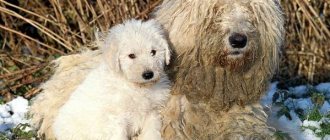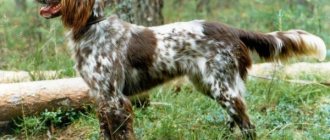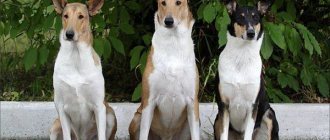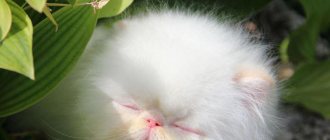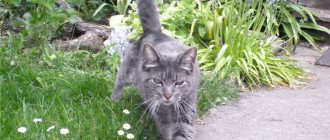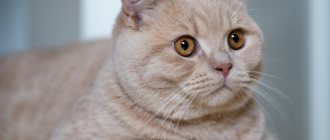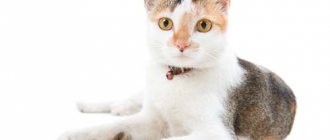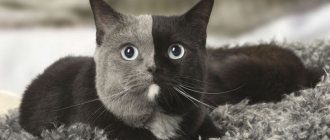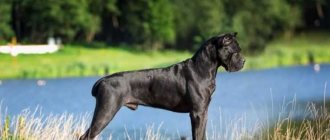History of the Hungarian Vizsla breed
The Hungarian Pointer comes from dogs of a fairly dense build with a slow run, which were used during bird hunting using a net. With the advent of hunting weapons, the need arose for a light breed with a fast running speed. Therefore, the ancestors of the Vizsla were crossed with other hunting breeds , for example, with Turkish dogs, which were characterized by a light build and fast running.
Thus, the Hungarian Shorthaired Pointer arose, an animal with desirable characteristics that performed its duties well in field hunting. During the First World War, the Vizsla as a breed was practically lost.
In the twenties of the twentieth century, Hungarian breeders decided to save their national hound. Several Hungarian Vizsla dogs were used for breeding material. As a result of the work of dog handlers, in 1936 a breed was developed that was recognized as the Vizsla Hungarian Shorthair.
Origin story
The first mention of Hungarian hunting dogs, which were the ancestors of the modern Vizslas, dates back to the 10th century. It appears in the Chronicle of Vienna, published in 1375 during the reign of King Louis the Great. The document states that the red dogs were excellent at hunting game, large hares and other small animals that lived on the fertile fields and wide plains of the state.
The Hungarian Vizsla is a versatile gun dog; it can work in the field, in the forest and on the water. She has a strong stance, excellent instincts, a love of water and an innate desire to retrieve game.
For centuries, these dogs were kept only by the Hungarian elite, which allowed them to preserve and enhance their working qualities. Since 1825, a stud book has been kept, which stores all pedigrees and standards. Around the same time, the breed was proclaimed the official pointing dog of Hungary.
Without any doubt, the breed has won the respect and hearts of the Hungarian people. Until the end of the 19th century, the government did its best to prevent the export of purebred Vizsas to other countries. After the First World War there were very few hunting dogs left, the breed was on the verge of extinction. This was the first and so far only time when something threatened her. Even in the 40s, despite the ruins and divided Europe, the number of Hungarian cops was stable. The Hungarian Vizsla carries the blood of different hunting dogs, German and English. Many people believe that the breeding work could not have happened without the Arabian greyhound - Slugi.
Video review of the Hungarian Vizsla dog breed:
Description of the Hungarian Vizsla breed, characteristics
Today the Vizsla is a versatile hunting dog . It performs a variety of duties on land and in water, and is characterized by an easy ride and a beautiful, solid stance. With great passion she scours the reeds, swims and brings prey from land and water.
Video: Hungarian Vizsla dog with an ideal character
Vizsla character
The Hungarian Vizsla is a friendly, affectionate and sociable dog . He has a playful disposition and never shows aggression. This is a faithful friend, infinitely devoted to his owner and will come to his defense at any moment .
The Vizsla is intelligent and has a unique sense of smell. The dog has a well-developed hunting instinct, so it copes well with its work in the field, forest and on the water.
The character of this dog largely depends on the temperament of the owner , since the Hungarian Vizslas are intuitive and sensitive, trying to please their beloved owner. At the same time, all Vizslas are hyperactive, and even in the house they are constantly on the alert: they sniff, search and watch.
The Hungarian Vizsla gets along well with children and can become a nanny even for a small child . You can leave your baby with this affectionate and good-natured dog without fear, she will not offend him herself and will not allow anyone else to do this .
towards other animals . She will quickly find playmates at the dog park. But it is quite difficult, and sometimes impossible , to accustom the Hungarian Vizsla to birds and rodents, since the hunting instinct still kicks in. But the Vizsla also has negative qualities :
- Grudge.
- Touchiness.
- The desire to manipulate the owner.
Many negative qualities appear in a breed if the dog is kept in the yard without giving it proper attention . The Vizsla's character literally deteriorates and she tends to exhibit manic behavior. The dog begins to bark for no reason, howl, dig the ground, and even gnaw its own body.
Therefore, life in an enclosure or kennel is not acceptable .
Hungarian Vizsla color
acceptable color - gold . According to the standard, red (aka ginger) and brown are a disadvantage, and the line between these palettes is very thin. From the experience of successful owners of show dogs, we can say that the color palette does not play a key role in assessing the exterior, which cannot be said about its intensity. The standard also allows for moderately darkened ears, a white patch (up to 5 cm in diameter) on the chest or front of the neck, and a small amount of white hair on the fingers.
Hungarian Vizsla breed standard
- Hungarian Vizsla breed standard FCI No. 57/04/06/2000
- Homeland: Hungary
- Classification (FCI): Group 7, Section 1
- General appearance The general appearance of the Hungarian Vizsla is elegance combined with an energetic disposition. This is an ordinary pointer with a rectangular muzzle on a very dry head. The eyes are slightly darker or to match the color of the coat, and the gaze is attentive and lively. The nose with wide nostrils, brown in color, rather large. The ears are drooping and long. The tail is not thin, set low, usually docked by one third. The body of the Vizsla is covered with short, shiny, close-fitting and dense hair.
- Behavior and character The Vizsla is a very active dog that is rarely in a calm state. But at the same time, the balanced character of the Hungarian cop ensures obedience and devotion. Usually they intuitively sense children and behave friendly and affectionately with them. They take great pleasure in participating in harmless outdoor games with children without the slightest hint of rudeness or carelessness. Vizslas have an innate passion for hunting, so they enthusiastically take part in any active activities. Such amazingly affectionate dogs quickly and forever become attached to their owner and his family. Extraordinary devotion to a person makes you take advantage of every opportunity to be close to a loved one. The Vizsla's endurance makes it the best partner for long distance runs or walks.
- Cranial region
- Skull: Slightly convex, of moderate width, with a prominent occipital protuberance.
Stop: smooth
- Head: noble in appearance, dry and in proportion to the body.
Nose: wide, well developed, with a straight back and movable nostrils. The color is slightly darker than the color of wool.
- Neck: proportional to the body, medium length.
Withers: well defined, long, muscular.
- Limbs: Parallel and straight, with well-developed muscles and bones.
Shoulder blades: long, flat and obliquely set, with pronounced articulation and strong, lean muscles.
- Limbs: parallel and straight, with excellent bone and joint set.
Knee joint: clearly expressed.
- The coat is hard and short, lying close to the skin. The hair on the head and ears is softer and shorter. On the underside of the tail the hair is slightly longer, and on the belly it is sparse. There is no undercoat.
Color: Solid: from dark red to golden red with a beige tint and an admixture of sable.
Video: dog breeds - Vizsla
Maintenance and care
An indisputable advantage of the Hungarian pointer is its ability to adapt to different living conditions of its owner. The Vizsla can live both in a city apartment and in rural areas. And if in the first case it will be a good companion, then in the second, thanks to its endurance and scent, the dog can be used as a guard. The Vizsla easily tolerates the road, so family road trips to the sea or to the mountains will be a joy for your dog.
The Hungarian Pointer is low maintenance. The Hungarian Shorthaired Pointer dog breed, unlike the wirehaired dog breed, does not even require brushing. It is enough to brush the fur once a week. Bathing the dog is also no more than once a week. For those who like to provide their dogs with the best, a piece of advice: purchase special coat sprays and use them before each walk. Sprays based on lanolin or wax have water-repellent properties - the Vizsla’s fur will get less dirty during street walks, but will still shine beautifully.
Since the Vizsla is a friendly dog, it does not like to stay at home by itself. To confirm this, the dog may demonstratively chew your shoes. Buy rubber toys for your dog and give it a clear place in the house. The Vizsla easily gets accustomed to order, so it will always lie only in its rightful place.+
Be prepared for the fact that, due to its mobility, your dog will often develop small wounds and cuts after walks. Every time you return home, carefully examine your pet's body. If you find wounds, wash them with warm water and treat them with regular peroxide. You will also need peroxide to care for the Vizsla’s ears. Inspect your ears daily and wipe them with a cotton swab soaked in peroxide.
The Hungarian Shorthaired Pointer, like the Wirehaired Pointer, tolerates water treatments very easily. Therefore, he actively takes part in games in the water. And if you have the opportunity, then in the spring and summer, be sure to take your dog to the river. After bathing, comb the Vizsla with a brush and let the fur dry on its own. The Hungarian Pointer requires active play, so swimming in a river or pond will only benefit the development and strengthening of its muscles. Remember that an active way of life is simply necessary. Otherwise, the dog will quickly gain weight and become passive and intolerant.
Nutrition of Hungarian Vizslas
special nutritional requirements for the Hungarian Vizsla . The main condition is the presence of all nutrients with reduced calorie and fat content.
The basis of natural feeding should be lean meat, vegetables and cereals. The diet also includes fermented milk products, cottage cheese, and an egg 2 times a week. A tablespoon of vegetable oil is added to food daily.
You should not give your dog:
- Sweet and floury.
- Potato.
- Fried and smoked products.
- I eat with spices.
Natural food must be supplemented with vitamins and minerals for dogs.
It is convenient to feed your dog dry food. You need to choose premium brands. The amount of food must match that recommended on the package, otherwise overfeeding will lead to obesity. Excess weight will not only spoil the dog’s appearance, but will also lead to the development of joint diseases.
The breed has increased mobility, so it should always have fresh water in its bowl .
What to feed?
A purebred dog won’t eat everything you put in its bowl, so it’s worth figuring out what to feed your dog and what food you shouldn’t use so as not to harm your pet’s health.
Puppy
You should immediately understand that the puppy’s initial diet is determined not by you, but by the person who sold it to you. Yes, in the first 2-3 weeks you should feed him the same thing that the seller fed him, so at the time of purchase you should definitely find out what the puppy was fed. As for the number of feedings, in the first 2 months, the vizsla needs to be fed 5-6 times, and the food needs to be renewed each time.
If the puppy does not eat, then you need to wait 10 minutes and remove the food, leaving an empty bowl. Additional complementary foods are not provided to discipline the dog. From the 2nd to the 4th months, you need to feed 3-4 times according to the scheme described above. Remember that a cop is always hungry, but that doesn't mean you need to fatten a pig that can't move.
This “hungry” state is normal for this breed. At the 7-8th month, the dog is fed no more than 2 times a day. After a year you can also feed 2 times.
As for feed, you can only use the most expensive options. Cheap dry or canned jelly-like options are prohibited. If you still want to try your luck, then be prepared for the fact that cheap food will cause allergies or digestive problems in the puppy, and its growth will slow down significantly, since such food is deprived of useful substances that are necessary for the dog.
If you decide to feed dry food, then at the initial stage you need to soak it with a small amount of warm water so that the puppy can consume it normally and not scratch the oral cavity. This is not to say that dry food is the best option, so consult with breed lovers and veterinarians about what is best to feed your puppy to ensure good health and sufficient energy.
Adult dog
As in the case of puppies, an adult dog can normally live his entire life on dry food, but you will have to purchase exclusively the premium option, which costs a lot of money.
You can feed the Vizsla not only with dry food, but also using the following products:
- lean meat (beef, turkey);
- low-fat cottage cheese;
- milk;
- liver;
- eggs;
- carrot;
- lean sea fish;
- bananas, apricots, pears.
As you may have noticed, the amount of fat in the diet should be minimal, but protein should be supplied in large quantities so that the dog’s muscular system can develop and receive the necessary “building material”. As for cereals, their quantity should be minimal. The fact is that porridge takes a very long time to digest and clogs the stomach.
At the same time, they supply the animal’s body with quite a lot of carbohydrates and a minimum of proteins, which is why such a product cannot be used for daily feeding.
Caring for Hungarian Vizslas and keeping dogs
This dog is not recommended to be kept in a kennel ; it is too domestic and does not tolerate loneliness well. You should also not leave your Hungarian Vizsla locked in an apartment all day.
The dog's place in the apartment should be located in such a way that the owner is in its field of vision most of the time.
- The Vizsla's coat does not require special care; it does not need to be combed even during shedding. It is enough to brush your dog once a week.
- A Vizsla should be bathed no more than once a month. The rest of the time the dog licks itself; it does not have the characteristic dog smell. Between baths, you can wipe the coat with a damp cloth soaked in a special lotion.
- Once a week, your pet needs to brush its teeth. For cleaning, use a special toothpaste and a brush that is placed on your finger.
- Once a month the dog's nails are trimmed.
Features of character and behavior
The Hungarian Vizsla is not your typical hunting dog. The breed is friendly to others. The animal gets along well with all strangers, never gets into conflicts, and does not “quarrel” even with cats and small rodents. The cop loves children, will play with them, but is unlikely to protect them from an enemy, because for this dog there are no bad people.
The Vizsla is very active, tireless, and hardy . She is ready to hunt all day long without feeling overtired. Animals have well-developed intellect and instinct; from birth they have all the necessary skills for work (stand up, follow the scent).
Another feature of the Hungarian Pointer is its attachment to humans. A dog cannot live without its owner for even a minute. She constantly needs contact with her family.
Raising and training the Hungarian Vizsla
Training and training a Hungarian Vizsla dog is a fascinating, interesting and enjoyable process for both the person and the pet. Vizslas are easy to train , and since they are very sensitive dogs, they always respond to encouragement and affection. The breed is tuned to absolute contact when working, thanks to the dog’s desire to please its owner in everything. Therefore, the owner of a Vizsla does not need severity, but perseverance and strong character . Being smart and attentive dogs, Vizslas will try to take advantage of the situation and take a dominant position in the family.
Vizslas who are unable to release their energy often become frustrated and bored, leading to character problems and manic behavior.
If such a dog is kept in the yard, away from interaction with people, it is likely to develop bad behavioral habits in the form of self-mutilation (abnormal scratching and chewing), barking and digging for no reason.
Character
The Hungarian Vizsla has a balanced temperament. These dogs are cheerful and friendly, they are easy to train and express a desire to constantly be with their owner. This is a real Velcro dog and you will have to get used to the fact that she will poke her red wet nose into any family matters. The Hungarian Vizsla is very affectionate, she quickly becomes attached to family members and is devoted to them to the tips of her ears. Although, as a rule, only one is recognized as the real owner.
The Hungarian Vizsla is a real bundle of energy that requires daily, long walks, regular training and attention.
If the dog does not receive this at the proper level, it becomes problematic in terms of behavior and obedience. When a Vizsla spends a lot of time alone in the yard, it develops bad habits: crying for no reason, digging holes. The Vizsla is very smart, can achieve what it wants by cunning, but almost never puts its own interests above those of its owner. At the same time, she is very sensitive and cannot stand rough treatment.
Vaccinations squeezed out
Vaccination is carried out against the following diseases:
- canine distemper or distemper;
- parvovirus enteritis - the causative agent is parvovirus;
- infectious hepatitis - causative agent hepadnavirus;
- parainfluenza;
- rabies;
- leptospirosis;
- coronavirus;
- trichophytosis.
When should a puppy have his first vaccination?
- At 2 months the first vaccination is carried out. After the injection, the puppy should not be washed, overfed or taken outside. Immunity after the first vaccine is developed within 12 days; this period becomes the most dangerous for the baby. A person needs to make a lot of effort to alleviate the puppy’s condition. After the first vaccination, puppies experience increased body temperature, general weakness and diarrhea.
- After 3 weeks, the puppy is given a second vaccination, but with the same vaccine. As a rule, after the second vaccination the dog feels much better, but for 12 days it must be protected from other animals, from drafts and not taken out for walks. After this time, walks are allowed.
- At 6 months of age, the puppy is vaccinated against rabies and a complex vaccine against several diseases. It is forbidden to vaccinate if the dog's teeth are changing. You need to wait until all the teeth are replaced, and then vaccinate the baby.
- At one year of age, the dog is given a comprehensive vaccine.
- Further, once a year the dog should be vaccinated with the same complex vaccine.
How to vaccinate a puppy?
Only a qualified specialist should vaccinate a puppy .
Before vaccination, he must examine the dog, measure its body temperature, and only if everything is normal, give the injection. The vaccine is placed either in the scruff of the neck or in the hip of the dog. The entire list of vaccinations administered by the veterinarian must be recorded in the dog’s passport. It also indicates the date of vaccination; subsequently, the owner himself will know the expected date of the next vaccination.
Hungarian Vizsla diseases, symptoms and treatment
The Hungarian Vizsla, which receives adequate exercise and nutrition, is a strong and disease-resistant dog. Average life expectancy is 14–15 years. The breed is not prone to colds and allergies, which is rare for short-haired four-legged animals. However, there are a number of occupational diseases, the risk of which cannot be excluded:
- Pathologies in the thyroid gland, hormonal imbalances.
- Dysplasia.
- Cataracts and retinal atrophy.
- Oncological diseases, especially in females that have not been spayed or untied.
- Epilepsy.
Breed standard
At the moment, there are 2 independent standards for the Hungarian Vizsla: short-haired and wire-haired pointers are considered as independent breeds. Both documents describe common characteristics:
- The height of dogs at the withers is significantly less than the length of the body.
- The muzzle makes up less than half of the head.
- The skull is convex and not too wide.
- The longitudinal groove on the head of the Vizsla is clearly marked and runs from the back of the head to the smooth beginning of the muzzle.
- The cop's large, well-developed nose is distinguished by movable nostrils.
- The nose is half a tone darker than the coat color.
- The lips fit well.
- The bite of cops is scissor-shaped with a full set of teeth.
- The cheekbones are pronounced.
- The Vizsla's eyes are set somewhat slanted.
- The iris is dark brown in color.
- Wide triangular hanging ears are located at medium height, slightly laid back.
- The well-muscled back of a cop goes into a short, straight loin and ends with a wide, sloping croup.
- The low-set tail does not rise above the line of the Vizsla's back. A quarter of the length can be docked.
- The chest bone reaches the line of the elbows.
- Straight legs are parallel and end in tightly compressed oval paws.
The shades of color are clearly visible in the photo of the Hungarian Vizsla, as well as the differences in the coat of the short-haired and wire-haired pointer breeds. The second is distinguished by thicker, coarser hair that fits tightly to the body.
Hungarian Vizslas in heat
What should a bitch owner know?
- age of onset of the first estrus in a female dog is 12-14 months;
- duration of estrus is 20-22 days, sometimes up to a month;
- frequency of estrus – 1-2 times a year with an interval of 6-9 months;
- signs of estrus – swelling of the dog’s external genitalia, spotting;
- frequent urination - having to walk more often than usual;
- psychological signs - a change in the dog’s behavior - from aggressive to lethargic;
- perhaps there is a change in appetite and the dog drinks more water;
- often bitches begin to shed before going into heat;
- lick the loop intensively.
How to notice the onset of heat?
You can notice the approach of estrus while walking your dog. Behavior can change, often the dog becomes active, playful and disobedient, or, on the contrary, looks unhappy and lethargic. The bitch makes frequent marks - scent “lures” for male dogs, and urination occurs more frequently. The loop becomes more and more swollen; when pressed, you can see a discharge of light pink or dull pink color. If you notice changes in the dog's behavior, do not be lazy and check the dog every day for the onset of heat by dabbing the bitch's loop with a napkin or toilet paper. Pinkish discharge will be the beginning of estrus - mark this day in your dog’s notebook.
The course of the dog's first heat.
- The first heat in dogs is not the same as the next one.
- It may be shorter or longer than the usual estrus period.
- The bitch has either only weak manifestations of estrus, or, conversely, very heavy discharge.
- The first heat may suddenly stop, and then after some time begin again.
- There may be mucous discharge from the loop, a smell that attracts males, and the estrus itself will begin after some time.
- Try not to miss the start time of the first, and subsequently the second estrus, in order to correctly determine the intervals between estrus and know their timing and duration.
Precautions during estrus.
If you are not interested in getting puppies from a dog, you need to take precautions during heat:
- walk your dog ONLY on a leash: even the most obedient dog these days can simply run away, not paying attention to commands;
- do not allow male dogs to mount the dog: if sexual intercourse begins, it is almost impossible to separate them;
- during a walk, literally DO NOT take your eyes off the dog, even when buying bread in a tent, eliminate or minimize contact with male dogs;
- there is a danger of the dog catching a cold in the cold season, the best way to protect yourself is not to walk for a very long time in cold weather and use dog clothes;
- If your dog lives freely on your territory, then from the moment the estrus begins, lock the dog in an enclosure.
How to choose a puppy
When thinking about choosing a Vizsla puppy, you need to take into account the characteristics of the breed. From childhood, kids will need a burst of energy, careful training, as well as space for walks and active games. You shouldn't buy a small cop just from a photo without any documents. The popular breed is bred by official nurseries. A conscientious Vizsla breeder will provide a complete set of puppy documents, and the pedigrees of the dogs will not have any flaws or inaccuracies.
It is worthwhile to determine in advance the purpose of the purchase and remember that show-class short-haired and wire-haired pointer puppies should not have breed defects or acquired defects. While there are somewhat fewer requirements for the pet class, dogs of this level are not allowed to be bred in the future.
When choosing a Vizsla puppy, you should pay attention to the following aspects:
- moderate fatness;
- active behavior;
- normal coordination of movements;
- shiny healthy coat;
- absence of eye and ear defects;
- the average size.
Mating of Hungarian Vizslas
In principle, the female is ready to meet a male and for her first heat, but you can’t breed so early!
The ideal days for mating are considered to be from 11 to 15 from the start of estrus. It is best to breed a female by the age of 2, just like males. Under no circumstances should males be bred before two years of age. Early sexual activity will not improve the health of either the dog or the offspring.
- Before mating, animals need to be given a good walk, but should not be fed. It is better to introduce dogs on neutral territory so that they can get to know each other and run around, and then lead them to the male dog’s territory.
- Matings should always be carried out only in the territory of the dog. Actually, an act of love can also happen during dating, so don’t interfere with the process.
So, you're in male territory. Most likely, no intervention will be required, and the bitch, having played enough with the male, will allow a persistent suitor to mount.
If one of the partners for mating is small in relation to the other, then you can place a pillow under the hind legs or, if the bitch is shorter, place her belly on a bent knee. This advice is more relevant for small breeds. Just don’t try to bend the bitch’s paws so that the dog can reach her.
After ejaculation, mating occurs. The male can be on the bitch or stand with his back to her. The animals will figure it out on their own. However, if the lady tries to break free or lie down, do not allow her, hold her back a little. Also try not to scare the dogs.
It happens that after mating, mating does not occur and the male immediately loses interest in the female.
Be sure to carry out a control mating after 24-48 hours.
Mating
Hungarian Vizslas are rare hunting dogs for which it is important to preserve their working skills in their natural state, therefore all matings must be official, club, sealed by an agreement. To ensure a high-quality litter, breeders make pairs of opposite dogs that complement each other’s strengths and weaknesses.
Large dogs require the intervention of a professional in mating. It is not so easy to help them, because you need to keep the female and male in one position for 15-20 minutes while the “lock” lasts. Vizslas are quite heavy, so the strength of both owners and the dog handler will be needed.
Pets are untied at 2 years old, then the maturation stage is completed, dogs are able to conceive, bear and give birth to healthy offspring. The female is brought to the territory of the male; you can walk the animals in advance and introduce them. On average, the act lasts 20-30 minutes.
Read a detailed article on the topic: “Everything you need to know about breeding dogs: appropriate age, what to do if it doesn’t work out, rules and tips.”
Hungarian Vizsla pregnancy and birth
From the day of the first mating to the birth itself, 56 to 72 days . It is advisable to note the day of mating in order to know how long the dogs are pregnant. Too early and too late births most often lead to the death of the litter, so in both of the above cases it is necessary to seek help from a qualified veterinarian. The gestation period in dogs may be shortened due to the small number of offspring.
Typically, young females produce fewer puppies.
The litter size increases when the dog reaches 3-4 years of age, then decreases again. The duration of pregnancy in dogs is not very long; it is not so easy to determine that a dog is pregnant.
Obvious signs of pregnancy in dogs appear at quite late stages. Neither palpation nor the appearance of the pet at an early stage of pregnancy will tell the owner whether the mated bitch is expecting offspring or not. The first signs concern not so much the external appearance as the mental state, and therefore the behavior of the pregnant bitch. The dog, as a rule, becomes calmer, shows affection more often and demands affection from others. Sometimes the animal may not even seem completely healthy.
If the pregnancy is progressing normally, the specialist can establish pregnancy by palpation in the third week. After a month, the dog’s belly noticeably enlarges, and in the fifth week the mammary glands swell and lighten. Shortly before giving birth, the bitch's belly drops. A characteristic sign of approaching labor is abundant discharge from the loop, yellowish or greenish in color.
Also prepare a “maternity kit” so that everything you need is at hand, it should include:
- old duvet covers or large disposable diapers (60*90), on which the bitch will whelp (disposable diapers are preferable - less washing and more cleanliness);
- a lot of small soft rags ironed with a hot iron from old bedding (to dry puppies);
- sterile gauze wipes (usually unnecessary, the puppy’s mouth is dried with a piece of cloth, into which, in fact, the puppy is received);
- a pen, a notebook, scales and thick woolen threads or ribbons (it is better to use floss, because the bitch simply licks and removes woolen threads);
- afterbirth bowl;
- a box or basin for puppies with a heating pad (wrapped in a diaper) - this is in case the bitch behaves restlessly during childbirth and there is a risk of losing puppies... the best option is a bitch giving birth with puppies at the nipples;
- sterile scissors and a medical clamp (it is not necessary to boil; at the onset of labor, place in a jar with any alcohol);
- milk chocolate bar;
- an antiseptic, preferably a spray (Aluminium, Xidicol, Septonex) for treating the umbilical cord.
And also a puppy resuscitation kit:
- cordiamine to stimulate cardiac activity (a drop on the tongue of a newborn);
- an oxygen canister (to give a weak puppy a chance to breathe), costs about 400 rubles in pharmacies;
- small rubber heating pad;
- a small enema for suctioning mucus from the mouth of a very weak puppy.
As for medications, during a normal birth they will not be needed, and if you had to resort to the help of a veterinarian, then he will have the necessary kit. Just in case, you can keep in stock No-shpu in ampoules, glucose 5% solution for infusion; calcium gluconate (a box, may be useful after childbirth).
You will also need a watch to mark the time of birth of the puppies and a notepad to record the details of the whelping (they will come in handy in the future), with your veterinarian's phone number displayed in a visible place. It's also great to have a scale for weighing newborn puppies. The puppy's birth weight, among other whelping details, should also be recorded in a notebook.
Bitches usually whelp between 58 and 63 days. Large litters are born earlier, and small ones a little later.
In the last days before whelping, you need to monitor the bitch’s body temperature. The normal temperature measured in the anus is about 38.5°C. Two days before giving birth, the bitch's temperature usually drops to 37°C or even lower. But since this does not always happen, you need to be attentive to all other signs of impending whelping. And yet, more often than not, if the temperature remains normal, then the bitch is unlikely to whelp in the next 24 hours.
Before whelping, it is good to give the bitch a mild laxative to help her cleanse her intestines.
It is better if, 2-3 days before the expected birth, you call a veterinarian or clinic, warning in advance about a possible call; in any case, the necessary phone numbers should be in a visible place.
Various questions about the Hungarian Vizsla breed
Is it true that there is a gray or blue Hungarian Vizsla?
This question is of great interest to “young” fans of the breed. Moreover, an artificial excitement is created around blue dogs! Essentially, any dog similar to a Vizsla but not meeting the standard will be considered a mixed breed. If the gray Hungarian Vizsla has become your dream, you should understand that such a dog will never be recognized as a purebred dog, much less be allowed for breeding. Moreover, under the guise of an expensive puppy with an exclusive color, you risk purchasing (not necessarily a purebred) Weimaraner.
Vizsla - noble Hungarian pointer
The Vizsla is a breed whose qualities were developed by hunting together with humans. The functions of the dog do not end there. Thanks to her perfect exterior and friendly disposition, she can act as a companion. Her good nature and ability to get along with children make her a family favorite. The excitement and physical activity of a dog will help even a lazy owner stay in shape.
Related breeds
Weimaraner
Weimaraner and Hungarian Vizsla
The Weimaraner captivates at first sight with its silver-gray coat color and amber eyes. In addition, they are considered the “blue blood” of the canine world for their high level of intelligence, excellent memory and ability to make independent decisions.
Weimaraners are called the intelligentsia of dogs. They are very delicate and have good manners. They love communication and are quite friendly, although we must not forget that these are hunting dogs and malice is in their blood. In addition, these dogs have a very freedom-loving character and do not tolerate being kept locked up. They want to be accepted as part of the family. And somehow calling a Weimaraner a pet doesn’t work either. She is too smart and quick-witted, besides, she is easy to train and can easily perform some household duties. This is the character of these silver German dogs with very smart eyes. That is why their price around the world is quite high.
Health
In their general population, Hungarian Vizslas are distinguished by a strong immune system and good endurance. They are not susceptible to major health problems. It is not uncommon for dogs to live up to 14 years and not get sick at all. They do not have breed-specific hereditary diseases. From this point of view, representatives of the breed are quite protected.
In addition to femoral dysplasia, some dogs have skin allergies to certain foods, particularly soybeans. Allergy is the body’s canine response to environmental allergens and food products. It can cause dermatological reactions ranging from pimples to more severe conditions. As for dysplasia, the problem is solved with the help of an examination, which is carried out before confirming the standard in order to obtain pedigree individuals with good pedigree. Animals that have not received status A or B, according to the official classification, do not undergo confirmation.
Vizslas get ear infections due to their long, closed ears. Common sense dictates that they should be kept properly clean. Most often, cleaning is carried out twice a week, using products designed specifically for dogs.
Like all canines with a deep and narrow chest, these dogs can experience gastric volvulus (dowsing syndrome). This condition requires immediate veterinary intervention. After providing first aid, it is important to fix the stomach in its anatomically normal position so as to avoid problems in the future. Often the intervention is carried out in two stages.
Returning from a hunt, it is important to carefully examine the dog’s skin where there are folds. The fact is that with the beginning of the hunting season, foreign plant particles, for example, thorns, can get stuck in these places. As for hunting, individuals who have reached sexual maturity, that is, the end of the growth period, are allowed to take part in the event. This will help avoid osteoarticular problems
Dog nicknames: names for Hungarian Vizslas
Most people prefer to choose a short, sonorous name for their dog.
You will have to say your dog's name many times a day, and if it is too long, it will be tiring.
When choosing what to call a Hungarian Vizsla, you can be guided by two methods.
- The first and easiest: open the list of the most suitable names for this breed and choose the one that you like best .
- Second: choose an unusual name from other sources, for example, from mythology or literature, name the dog after your favorite celebrity , or come up with your own exclusive name .
There are many suitable names for Vizsla girls:
- Alli,
- Betty,
- Dina,
- Greta,
- Isis,
- Lizzie
The following names are good for a Hungarian Vizsla boy:
- Ara,
- Jerry (however, there is also a female name Jerry),
- Jewel,
- Gaston,
- Don,
- Iris.
How much do puppies cost?
The cost of Hungarian Vizsla puppies depends on factors such as the reputation of the nursery, the achievements of the parents, compliance with the breed standard and the sex of the baby. The average price for such a dog is 45 thousand rubles. A champion puppy with no defects is valued at 70-100 thousand, as it has a better chance of gaining recognition at shows. A good working dog for hunting without the need for breeding can be bought for 20 thousand.
Nurseries
There are several Hungarian Vizsla nurseries in Russia, where you can buy a puppy, get advice on training and maintenance, and also choose a partner for mating. Of these, 3 are located in Moscow:
- The private nursery “Call of the Fields” is engaged in breeding working lines of the shorthaired breed. In addition to the Vizsla, there are Weimaraner and Drahthaar puppies (https://dog.pet2me.com).
- Another private one offers short-haired puppies and dog training services (https://shilla-line.ru).
- Along with the short-haired Hungarian Vizsla, the Gern-Gross breeding kennel is engaged in breeding the wire-haired breed. There are also shorthaired pointers, Weimaraners, miniature pinschers and Manchester terriers (https://www.pointing-dogs.ru).
In St. Petersburg, you can find shorthaired Vizsla puppies at Lembo Prout, where shorthaired pointers, Yorkshire terriers and Chihuahuas are also bred (https://www.lembopraut.ru).
Summarizing everything about the Hungarian Vizsla breed, we can call it not just a hardy, unpretentious hunter, but also a faithful, devoted friend. The dog will generously repay with love the time and effort spent on its upbringing. Thanks to its indomitable energy and cheerful disposition, the short-haired and wire-haired pointer is suitable for both an active hunter and a large family with grown-up children.
Owner reviews of the Hungarian Vizsla
The dog is very obedient . She stays alone at home all day, but she hasn’t chewed on a single thing. He even handles his toys carefully and doesn’t chew them. Loves to play with my son, he is 10 years old. Runs with him when he rides his bike. I learned the commands very quickly .
Natalya I have been the owner of a Hungarian pointer Vizsla in an apartment for 9 months now. I’ll say right away that the dog is NOT an apartment dog, in the sense that in an apartment she, with her irrepressible energy, will be too bored and cramped, so she will tear up everything ... EVERYTHING that is good and bad.
I don't recommend leaving her alone. She is very bored and will harm you (either crap or tear at you). Immediate recommendation: just don’t pay attention to it, regardless of the damage and your upset. As they write on the Internet, this is really a Velcro dog, and you will need to get used to doing your business with its nose in your hand, sometimes it seems that it is simply magnetized to a person.
She loves everyone and everything . She is happy with everything, absolutely. But don’t believe that if you don’t care about her, she will calmly lie down at your feet. NO! - she will find something to occupy herself with. And what’s more, he will pester and annoy you with his games, jumping and running around like a top. This is a super hyper-reactive dog. Therefore, you will definitely have to either take her for a long walk, or find a group of dogs with whom she can rage (and really rage) without a leash. As she gets older, yes, she becomes calmer, but not too much; if there is someone at home, she will not lie down for a minute.
Outwardly, yes, this is a very beautiful dog, we cannot pass anywhere without receiving just a lot of compliments, everyone wants to touch her, the children are delighted, BUT I will immediately note that due to her mobility, she is very careless and can easily knock over, scratch , bite a child in play, so I don’t recommend keeping a Vizsla with very young children. It doesn’t smell - yes, this is indeed true, but maybe also because it has to be rinsed with water almost every day after evening games with the flock. The coat is short and smooth, there is no undercoat, but it sheds a lot . So a short-haired dog is not an escape from hair. In addition, it digs into clothes and is not always easy to remove with a sticky roller. There is no saliva flowing , even with jowls. If he eats something very tasty, with a strong taste, then he can whip up foam on his lips and that’s it. He eats little, doesn’t always agree, chooses, is picky. What else - the dog is simply hyper smart , except that it doesn’t speak, training without problems and willingly. He constantly hunts pigeons on the street. It is very difficult, perhaps even impossible, to walk past other dogs calmly - you urgently need to play.
Conclusion: if you have no experience with dogs, if you are inactive and lazy, if you don’t like to walk for a long time in the fresh air, if you can’t go out into nature (dacha), don’t get a Vizsla.
Olga
Nutrition
Feeding is organized on simple principles. Always and everywhere food is a blessing that must be treated with respect. When moving away from the bowl, the remaining food is removed. There should be no intermediate snacks between feedings. You can’t feed him food from the owner’s table.
When compiling a diet, you need to take into account that the Hungarian Pointing Vizsla is a hunting dog. Even if she never heard the sound of a gunshot. The diet of hunters is similar to that of athletes. There can be two strategies:
- nutrition with natural products,
- use of dry food.
Dog trainers often recommend choosing natural products. From many veterinarians you can hear recommendations for the use of dry ready-made food. Natural nutrition usually contains a lot of protein foods with the addition of vegetables, without including cereals. Dry food makes the owner's life easier. They are easy to match to the age and breed of the dog.
Choosing a Hungarian Vizsla puppy
The Hungarian Vizsla is a currently popular breed, so there are a lot of nurseries for its breeding. It is better to purchase a puppy from a specialized nursery, although prices there are higher than from private breeders. At the same time, buying a puppy from a kennel can serve as a guarantee of receiving a purebred dog, with all the documents and pedigree.
- When choosing, you should pay attention to an active, active puppy.
- He should be well-fed, but not thick, with shiny coat.
- It is recommended to choose a medium sized puppy.
- He should not have any defects in his eyes or ears.
Who is the breed suitable for?
- Hunters . This point is all clear. Hunting dogs must hunt, and the ideal owner for a Vizsla is a hunter. In any weather and in any conditions, pets are ready to be close to their hunter owner.
- Active people . If you are not a hunter, but like to spend your free time actively, play sports, are passionate about hiking, or just run every day in the morning, take a Vizsla as your companion. Dogs of this breed do not like to sit idle. They prefer an active walk to sleeping on the couch.
- Families with children of middle and high school age. The Hungarian Vizsla can become a friend and active companion for your children when they grow up. We wrote about the dangers of bringing children into families with small children a little higher. Teenagers and high school students will be able to control the dog, and it will respond to them with its affection and devotion.
Cost of Hungarian Vizsla - price of puppies
- The price of the Hungarian Vizsla is relatively high - from 20,000 to 110,000 rubles. It depends on various factors. A puppy without a pedigree can be bought from your own hands for a minimal price.
- A puppy with an excellent pedigree, purchased from a specialized nursery, will cost at least 45,000 rubles.
How much does a Hungarian Vizsla puppy cost on Avito?
Current prices for Hungarian Vizsla puppies in Russia can be found in the advertisements at the link: https://www.avito.ru/rossiya/sobaki?s=101&q=%D0%92%D0%B5%D0%BD%D0%B3%D0 %B5%D1%80%D1%81%D0%BA%D0%B0%D1%8F+%D0%B2%D1%8B%D0%B6%D0%BB%D0%B0
Breed characteristics
| Short description | |
| Origin: | Hungary |
| Conditions of detention: | House, local area |
| Purpose: | Hunting dog, companion |
| Color: | Red-golden, red |
| Wool length: | Short, smooth coat or medium-length harsh coat |
| Adult dog size: | The height of the female is 54-60 cm, the male is 58-64; male weight – 25-27 kg, female – 20-25 kg |
| Average life expectancy: | 12-14 years old |
| Walk: | A long walk twice a day is required, even when kept on the street. |
| Physical activity needs: | High physical activity needs (hunting, jogging, swimming) |
| Fédération Cynologique Internationale (FIC) classification: | Group 7: cops; section: continental pointers |
| Puppy price: | From 42,000 rubles to 80,000 rubles. Pet class – up to 45,000 rubles, breed class – up to 60,000 rubles, show class – 70,000-80,000 rubles. |
